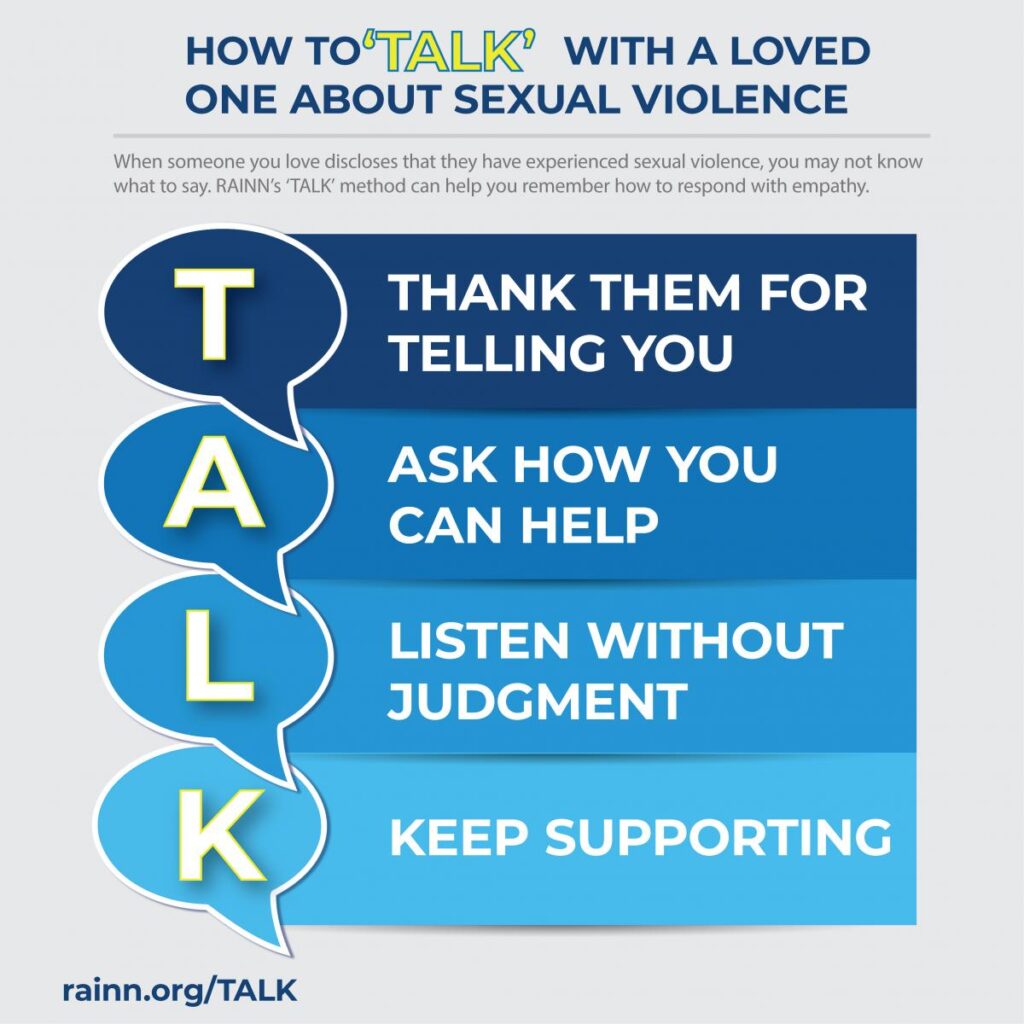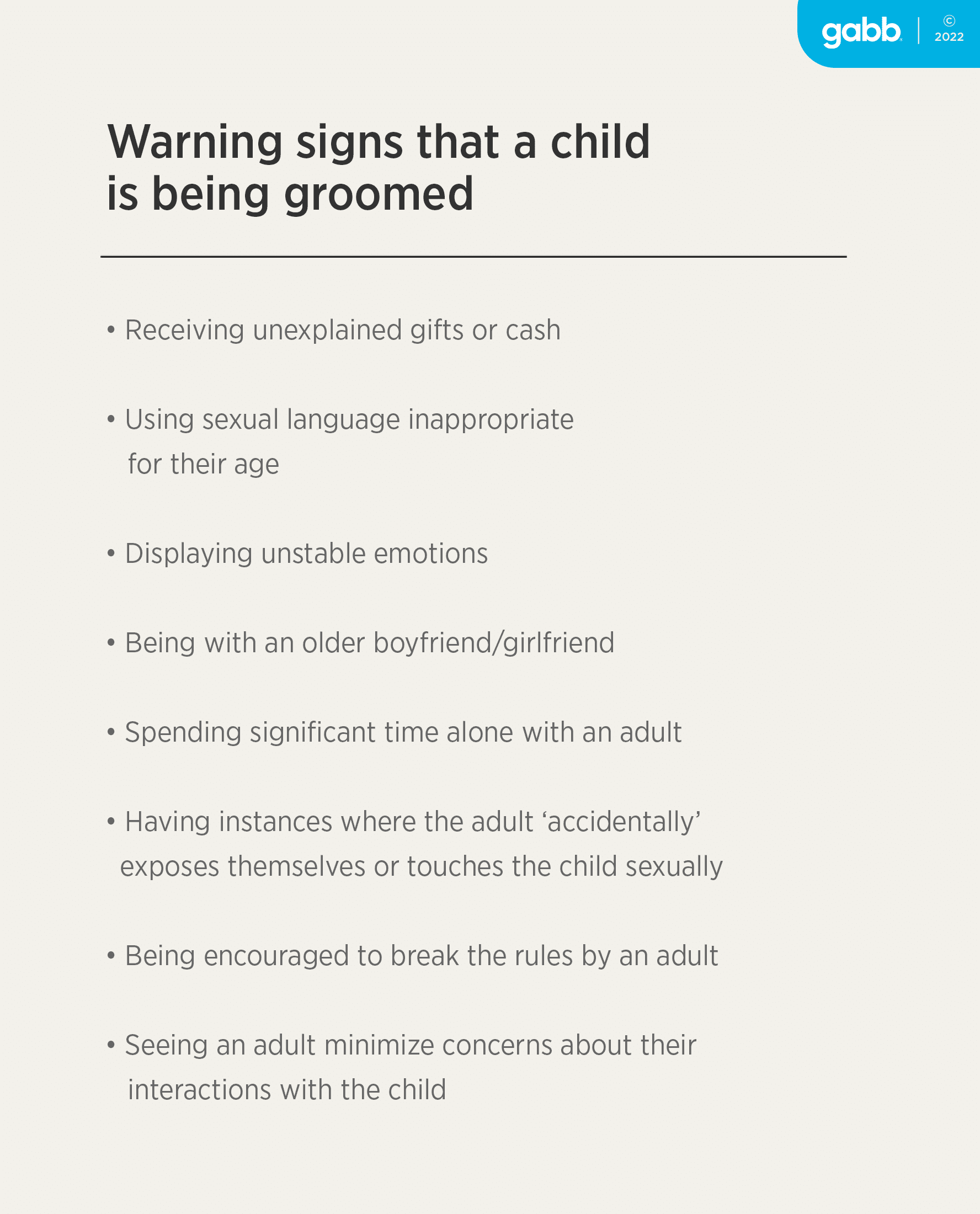Signs of Grooming: How to Protect Your Kids
Shield your child from predators by learning how to recognize grooming red flags and keep your children safe
APR 14, 2022
Signs of Grooming: How to Protect Your Kids
Shield your child from predators by learning how to recognize grooming red flags and keep your children safe
What are the 5 Stages of Grooming?
- Select a victim
- Gain access to & isolate the victim
- Develop trust
- Desensitize the child
- Maintain control
Don't miss out on any educational resources! Sign up for the latest information on how you can empower and protect your family.
Definition: What Is Grooming?
Grooming is the manipulative process sexual predators use to identify, coerce, and silence their victims. Predators can use in-person or online interactions to exploit people, namely children.
They can also groom parents and family members to gain greater access to victims, diminish the credibility of claims against them, and ultimately minimize their risk of being caught.
Grooming is the manipulative process sexual predators use to identify, coerce, and silence their victims.
Groomers try to imitate normal interactions between young people and adults, making it hard to detect (Winters et al., 2020, p. 856). However, you can recognize potential red flags and protect your children from predators by getting educated about grooming behaviors.
Predators imitate normal relationships with kids, but they soon push the boundaries of appropriate behavior.
The Pattern of Grooming & 5 Tactics Predators Take
Sexual predators typically follow a similar model in grooming their victims. This model consists of five stages (Winters et al., 2020, p. 860).
Not every predator will always go through these stages, nor will they necessarily follow them in this order. Groomers will move back and forth between stages and skip parts of the model depending on the child’s response to their advances (Winters et al., 2020, p. 867). For instance, a predator might backtrack a step and refocus on gaining the trust of a child who expresses discomfort or alarm at the predator’s physical advances.
Despite its fluidity, use this model to identify red flags. Parents can question the motive of an acquaintance who repeatedly offers to drive a child home, tutor them at their house, or make other requests to spend alone time with the child.
Be comfortable questioning the motives of an acquaintance who makes requests to spend time alone with your child.
It’s important to note that not every offer to work with a child or help your family will have nefarious intentions. Most of the time, adults trying to make positive impacts in a child’s life will have good and noble designs. The benefit of learning about these grooming behaviors isn’t to question every interaction between your child and the adults in their life but to be on the lookout for clusters, high frequency, or severe examples of suspicious behaviors (Winters et al., 2020, p. 868).

1. Select a victim
Offenders often observe and gather personal information about potential victims before taking other steps. Particular physical characteristics (youth, body type), distinct psychological traits (trusting, low self-esteem), and family circumstances (discord, single-parent home) stand out and heighten a child’s risk (RAINN, 2020).
2. Gain access to & isolate the victim
Abusers will take steps to isolate the child from others. They might sign up to coach, volunteer to tutor, or offer to help babysit. If the activities are not already private, an abuser will often try to create situations to be alone with the child. This might include private practice sessions, special day trips, or requests for the child’s help at the predator’s house (Winters et al., 2020, p. 861).
3. Develop trust
Predators will often try to gain a victim’s trust. They want to convince the child they are likable, loving, caring, and reliable. Their techniques can be found in the following list (Winters et al., 2020; Greene-Colozzi et al., 2020; RAINN, 2020):
How predators gain a child’s trust
- Offering gifts, money, toys, and treats
- Taking the child on trips
- Giving compliments
- Offering support, love, stability, and protection
- Listening to and validating feelings
- Showing interest in hobbies, goals, likes, and dislikes
- Serving in the community
- Showing favoritism toward the child
- Providing drugs, alcohol, or adult entertainment
- Sharing secrets and making the child feel important
4. Desensitize the child
Offenders will try to desensitize their victims by making their sexual advances seem normal or natural. They might discuss explicit sexual content, tell dirty jokes, share pornography, or ask about the victim’s sex life. They may also touch victims in apparently harmless ways—tickling, hugging, or wrestling—before escalating to more sexual contact like massages, showering, or asking for nude pictures (RAINN, 2020).
Often, gaining trust and desensitizing the child will go hand in hand. For instance, a predator may compliment the child on their body or offer to be a guide in exploring sexuality. Consequently, minors can develop a deep emotional connection with their abusers that they don’t consider themselves victims. Even after child sexual abuse has occurred, survivors might report that they are in love or in a relationship with their abusers rather than victims of sexual predation (Gámez-Guadix et al., 2018, p. 13).
5. Maintain control
Groomers often take steps to maintain control of their victims after sexually abusing them. They might do this to ensure future exploitation and prevent the child from disclosing their actions to others. Additionally, predators might bribe, threaten, or blackmail victims to remain silent and subservient (Gámez-Guadix et al., 2018, p. 16).

Changes in Behavior May Signal Abuse
It is a challenge to separate the signs of online sexual abuse from teenage angst. Experts caution parents to look for changes in concerning behavior and to engage in conversations about their digital lives often.
Children who experience online sexual abuse often feel shame, guilt, and confusion (source), often isolating themselves from others. Signs that a child has been abused may manifest in the following behaviors.
Changes in internet behavior
An uptick in internet use, or increased anxiety or fear when internet access is denied is cause for concern.
Hiding online activity can be worrisome. Predators encourage secrecy, and even use a lexicon of acronyms that encourage deceptive behavior (link out to our asset on that).
Kids may be especially vague or secretive, often changing screens or placing devices face down when approached unexpectedly.
Changes in sexual behavior
It is not unusual for children to be curious about human anatomy, and many children engage in what experts call early childhood exploration.
When a young child shows knowledge about sex that is not age-appropriate, or engages in sexual talk or conduct with peers, this may signal that the child has been abused.
Changes in social behavior
Online sexual abuse impacts social relationships. It is common for victims to withdraw from friendships and activities they once enjoyed. Another red flag is decreased school attendance or performance.
Perpetrators often seek to maintain control by sending their victims money or gifts. Unexplained possessions or cash can signal that there is a problem.

Grooming the Family & Community
Predators will often go through a similar grooming process with the victim’s family or community. They might spend time with, show interest in, and offer to help the families they are grooming. Similarly, they might work to enhance their social prestige in the community or gain others’ trust and confidence (Greene-Colozzi et al., 2020; RAINN, 2020).
By grooming parents and community members, predators can increase their access to young people, quickly build relationships of trust with kids, and decrease the likelihood that others will believe any potential accusations made by their victims (Winters et al., 2020; RAINN, 2020).
Online Grooming & Its Forms
Online predators accelerate the grooming process by introducing sexual content within the first 24 hours of chatting, sometimes within 30 minutes.
The process used by online groomers is similar to in-person predators, only accelerated. They often introduce sexualized content within the first 24 hours of chatting and sometimes within 30 minutes (Greene-Colozzi et al., 2020, p. 839).
For the most part, online predators adapt the five stages (identify, access and isolate, gain trust, desensitize, and maintain control) to fit digital interactions. For instance, instead of coaching a youth soccer team, predators might go to online gaming sites popular with children—such as Roblox, Fortnite, or Minecraft—to identify potential victims.
If the initial platform doesn’t allow for private chat, they will try to increase access and isolation by moving their conversations with their victims to social media sites—like TikTok, Instagram, or Snapchat—that give them more freedom to interact uncensored.
To build trust, online predators might pose as a child the same age as the victim or a slightly older member of the opposite sex (Greene-Colozzi et al., 2020, p. 839). Predators can even create multiple fake accounts under different names. They then ‘introduce’ their victim to their ‘friends’ and create a web of false security.
Signs of Grooming
Grooming can be hard to recognize because it seeks to imitate normal adult-child interactions. With that being said, there are red flags that can alert you that something is amiss with your child (“The stages,” 2018; The Massachusetts Legislative Task Force on Sexual Abuse Prevention, 2017).
Again, parents can avoid unnecessary paranoia that every adult is out to harm their children by looking for clusters, high frequency, or examples of suspicious behaviors (Winters et al., 2020, p. 868).
Signs of grooming by a parent or family member
Teachers, coaches, community leaders, and other adults can help parents look for signs of grooming in young people. Unfortunately, instances of parents sexually abusing their children are all too common, accounting for 35% of all instances of abuse (Wolf & Pruitt, 2019, p. 347).
For this reason, stay aware of potential warning signs that a child is being sexually abused by a parent or other family member (The Massachusetts Legislative Task Force on Sexual Abuse Prevention, 2017, p. 112).
Parents would benefit from learning more about grooming tactics so that suspicion may be raised if clusters, high-frequency use, or the most severe [example] of these potentially worrisome behaviors are present in a person spending time with children.
—Dr. Georgia M. Winters, Assistant Professor, School of Psychology and Counseling, Fairleigh Dickinson University
What are signs of online grooming?
Aside from those mentioned above, there are also other signs of online grooming to watch for. Without hesitation, parents should feel empowered to ask questions and require explanations from any adult who spends time with their children. The adults whose intentions are to support your kids must be willing to be completely transparent.
Effects of Grooming
Grooming impacts children differently depending on several factors, such as the methods used by the groomer, their relationship with the groomer, their other relationships with adults, the length of their grooming, how it ended, the extent of the abuse they suffered, and their natural disposition.
Sadly, children who experience unwanted sexual solicitation are 3x more likely to experience depressive symptoms or posttraumatic stress disorder, 2.6 times as likely to abuse drugs and alcohol, and nearly twice as likely to commit delinquent crimes. When abused, the effects are worse—10.5 times as likely to experience depression, 8.5 times higher rates of substance abuse, and 5 times more likely to engage in criminal behavior (Mitchell et al., 2007, p. 320).
Young people who have been victims of sexual predation are also more likely to struggle in school, display violent behavior, and commit suicide (The Massachusetts Legislative Task Force on Sexual Abuse Prevention, 2017, p. 22).

What to Do if a Child Reveals They’ve Been Groomed or Abused
Though a child has been groomed, it doesn’t mean all hope is lost. The sooner the grooming is identified and stopped, the less likely they will experience negative effects in the long term (The Massachusetts Legislative Task Force on Sexual Abuse Prevention, 2017, p. 22). Even if grooming or sexual abuse has been occurring for years, parents can always improve the situation by offering support and getting their child professional help (Cowan et al., 2020, p. 26).
If a child tells you they’ve been abused, they trust you. The Rape, Abuse & Incest National Network (RAINN) advises adults in this situation to remember the acronym TALK:

For more information on how to support a survivor, visit the RAINN website.
RAINN is an excellent resource for any adult working with children. They offer quality information on how to talk to a child if you suspect they are being groomed or sexually abused, how bystanders can help prevent child sexual abuse, and more.
How to Report Grooming
If you have a suspicion that a child is being groomed or has been sexually assaulted, you should report this to the proper authorities. Reporting varies depending on what state you’re in. For specific information on how to report in your state, go to RAINN’s State Law Database.
For support reach out to Saprea, or call or text the Childhelp National Abuse Hotline at 800-422-4453. Volunteer counselors can’t make the report for you, but they can help you navigate the reporting process and answer any questions you may have.
Support can be found through Saprea.
Saprea is a 501(c)(3) nonprofit that exists to liberate individuals and society from child sexual abuse and its lasting impacts. Through research-based prevention tools, Saprea educates caregivers on how to identify the signs and reduce the risks of child sexual abuse. As parents proactively address and model healthy boundaries, communication, and consent—both online and offline—children and teens will be better prepared to connect with others safely and healthily.
















rhoy on Sep 19, 2023 12:41 AM
Very good and very helpful, thank you very much. God bless